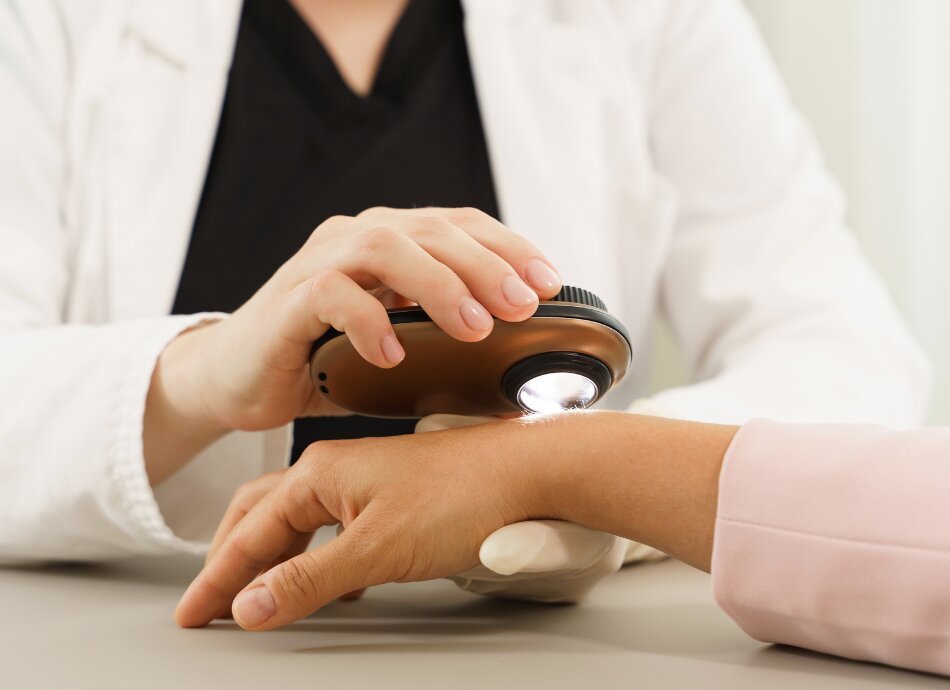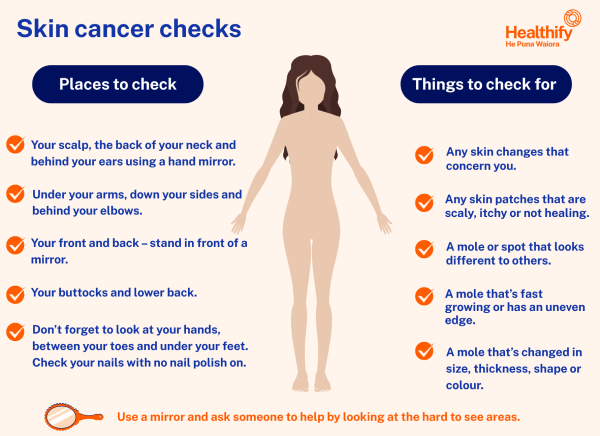Skin cancer checks
Key points about skin cancer checks
- Finding skin cancer early can save lives.
- It's important to be familiar with your skin so you can notice any changes. Skin cancers often don't hurt or cause other symptoms.
- Some can be very obvious, others can only be seen with a dermatoscope.
- Protecting your skin from the sun by using sunscreen, seeking shade, wearing long sleeves and a sun hat, and avoiding tanning beds can reduce your risk of skin cancer.
- Everyone’s skin is different. Talk to your healthcare provider about your risk factors and how to spot skin cancer early.

Skin cancer happens when skin cells are damaged, usually by UV radiation from the sun, and grow in an uncontrollable way. It’s the most common cancer affecting New Zealanders, however, it’s largely preventable if you're sun-smart.
If you protect your skin from sun damage throughout your life, you’ll greatly reduce your risk of skin cancer.
There are 3 groups of skin cancers:
- Melanoma, including nodular melanoma.
- Non-melanoma including basal cell carcinoma and squamous cell carcinoma.
- Suspicious patches which could be early skin cancers that need to be checked regularly.
Melanoma is the most serious type of skin cancer and is the cause of more than 2 out of 3 deaths from skin cancer. Read more about skin cancer and the different types of skin cancers.
It's important to check your skin regularly for any new spots or changes to moles and freckles. Skin cancers can be in places you can’t easily see yourself, like on your back or scalp. You might need to use a mirror or get a partner or family member to check hard-to-see areas.
Make sure you check your entire body, even areas that might not get exposed to sun, as skin cancers can occur anywhere. These include:
- the soles of your feet
- between your fingers and toes
- under your nails
- your armpits
- behind your ears
- in your hair on your scalp.
It’s a good idea to keep track of how freckles, spots and moles look so you’ll know if they have changed since you last checked.

Image credit: Healthify He Puna Waiora
Video: Self examination skin check
Most of us have freckles, moles and rough spots on our skin, especially as we start to age. Here are some things to look out for when checking your skin:
- Anything new, or changes to spots and moles
- Moles that grow quickly
- An outline of a mole that becomes notched
- The surface of a mole or spot becoming rough, scaly, swollen or itchy
- A skin spot that weeps or bleeds
- A sore that doesn’t heal
- A mole or spot that looks different from others around it
- A mole that’s changed in size, thickness, shape, colour, eg, from brown to black.
Be familiar with the ABCDEFG of melanoma detection
Think ABCDEFG when checking existing moles or new spots:
- Asymmetry – one half is different than the other.
- Border – edges are often irregular or ragged.
- Colour – the spot may be uneven in colour, ranging from brown to black.
- Different – the spot looks different from the ones around it – an 'ugly duckling'.
- Evolution – the spot is new or has changed appearance since you last checked it.
- Firm – the spot is firm to touch
- Growing – the spot is bigger than 6 mm across and keeps getting bigger
Don’t wait
If you notice any changes or have any areas of your skin you’re concerned about, see your healthcare provider or a skin specialist with expertise in skin conditions and skin cancers. Skin changes don’t necessarily mean you have skin cancer but it’s important to get them checked by a professional. Noticing a change in your skin early means it’s more likely to be successfully treated.
- Your skin type: All skin types can be damaged by too much UV radiation, but people with fair skin, freckles, red or blonde hair, and light-coloured eyes are more at risk. This is because they have a skin type that burns easily. People with dark skin still need to take care in the sun, even if they rarely or ever get sunburnt.
- Too much sun: Skin damage due to sunburn, using tanning devices, or having spent lots of work or leisure time outside increases your risk of skin cancer.
- Other factors: Having skin that has many or larger moles, a family or personal history of skin cancer or a weakened immune system can also increase your risk.
Apps reviewed by Healthify
You might find it useful to look at some skin check apps.
Check your skin(external link) Sunsmart, NZ
The melanoma symptoms to watch for – and tips to help spot them(external link) Molemap, Australia (has good images)
Brochures
Tirohia tō kiri | Check your skin(external link) Skin cancer flyer, Cancer Society NZ
References
- Facts and risk factors(external link) Melanoma NZ
- Check your skin(external link) Sunsmart, NZ
- Check for signs of skin cancer(external link) Cancer Council, Australia
- Early detection of melanoma and assessment of asymptomatic people at high risk(external link) BPAC, NZ, 2021
Credits: Healthify editorial team. Healthify is brought to you by Health Navigator Charitable Trust.
Reviewed by: Dr Lottie Wilson, General Practitioner, Queenstown
Last reviewed:





